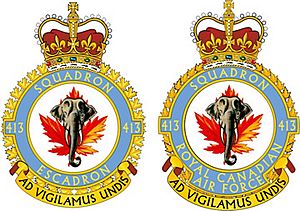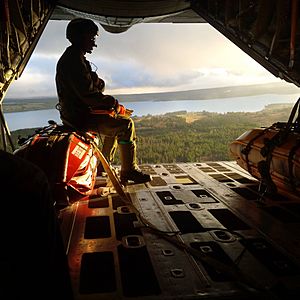413 Transport and Rescue Squadron facts for kids
Quick facts for kids 413 Transport and Rescue Squadron |
|
|---|---|

Squadron badge
|
|
| Active | 1941–1945 1947–1950 1951–1961 1968–present |
| Country | |
| Branch | |
| Role | Transport and rescue |
| Part of | 14 Wing Greenwood |
| Home station | CFB Greenwood |
| Nickname(s) | Tusker |
| Motto(s) | Ad vigilamus undis ("We watch the waves") |
| Battle honours |
|
| Insignia | |
| Squadron Badge | Elephant head over a maple leaf |
| Aircraft flown | |
| Fighter | F-86 Sabre Avro CF-100 |
| Patrol | PBY Catalina |
| Transport | CH-113 Labrador C-130 Hercules CH-149 Cormorant |
The 413 Transport and Rescue Squadron is a special team in the Canadian Armed Forces. They are part of the Royal Canadian Air Force. This squadron helps people in trouble and transports important supplies. They use big planes like the C-130 Hercules and helicopters like the CH-149 Cormorant. Their home base is CFB Greenwood in Canada.
Contents
Squadron History: From War to Rescue
The 413 Squadron has a long and interesting history. It started during the Second World War.
Early Days: World War II Missions
The squadron began in 1941. They used PBY Catalina flying boats. These planes could land on water. Their job was to fly over the North Atlantic Ocean. They looked for enemy submarines and kept an eye on the seas.
In 1942, the squadron moved to Ceylon (now Sri Lanka). Here, a brave pilot named Squadron Leader Leonard Birchall spotted a large Japanese fleet. This warning gave the defenders time to get ready. It helped protect the Royal Navy in the Indian Ocean. The squadron continued to fly important missions over the Indian Ocean until 1945.
Changes and New Roles
After the war, the squadron was put on hold for a short time. It started up again in 1947 at CFB Rockcliffe. This time, they took photos from the air. This role lasted until 1950.
The squadron reformed again in 1951. They became a fighter squadron at CFB Bagotville. They flew planes like the F-86 Sabre and the Avro CF-100. In 1953, they even went to Germany. The squadron was put on hold again in 1961.
Modern Rescue Operations Begin
The 413 Squadron started its current job in 1968. They became a Transport and Rescue Squadron. They were based at CFB Summerside. Later, in 1991, they moved to CFB Greenwood. During this time, they used the CH-113 Labrador helicopter.
In 2006, the squadron had a sad accident during a training exercise. A CH-149 Cormorant helicopter crashed. Three crew members died, and others were hurt. This was a difficult time for the squadron.
In 2015, the squadron welcomed a new leader, LCol James Marshall. He took over from LCol Scott Murphy.
What the Squadron Does Today
The 413 Transport and Rescue Squadron (TRS) is very busy. They perform search and rescue missions. They also airlift supplies across a huge area in eastern Canada. This area is about 1,800,000 square miles!
Who Works Here?
About 200 people work in the squadron. This includes the flight crews who fly the planes and helicopters. There are also teams who fix the aircraft. Plus, there are people who handle all the office work and support.
Where Do They Operate?
The 413 Squadron is the main air search and rescue team on Canada's East Coast. Their area covers a vast region. It goes from southern Nova Scotia all the way north to Iqaluit. This is on Baffin Island! It stretches west to Quebec City and east into the middle of the Atlantic Ocean.
Ready for Action: 24/7 Standby
The Joint Rescue Coordination Centre in Halifax controls the squadron's missions. They use one Hercules plane and four Cormorant helicopters for rescue. The 413 Squadron always has crews ready. They are on standby 24 hours a day, every day of the year. They respond to many different emergencies:
- Ships or planes in trouble.
- Medical emergencies where people need to be moved quickly.
- Searching for people who are lost.
Working with Volunteers
The squadron works closely with a group called the Civil Air Search and Rescue Association (CASARA). This is a non-profit group of volunteers. The Hercules and Cormorant crews visit different CASARA zones each year. They help train CASARA members to be good spotters during searches.
Global Transport Missions
Besides rescue, the 413 Squadron also helps with global transport. They use one Hercules plane for this. These missions can be for:
- Helping people in need (humanitarian aid).
- Supporting other Canadian Forces units around the world.
Most of these missions are in North America, the Caribbean, or Western Europe. But they can go anywhere in the world if needed!


